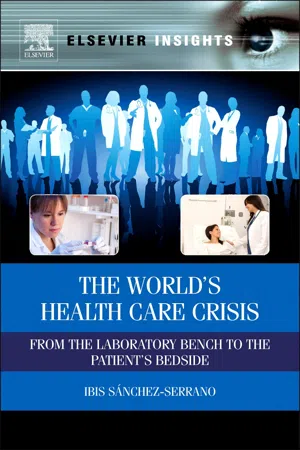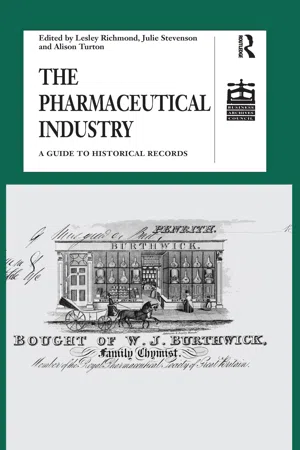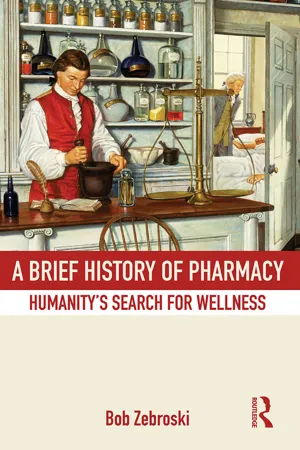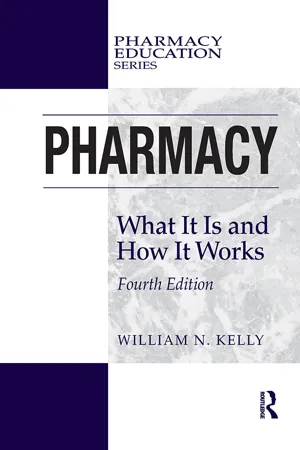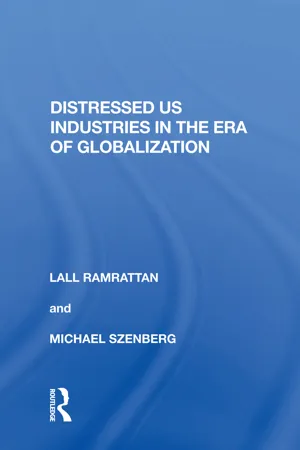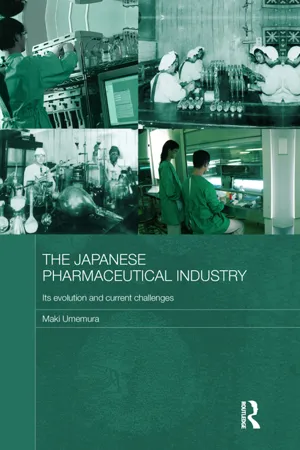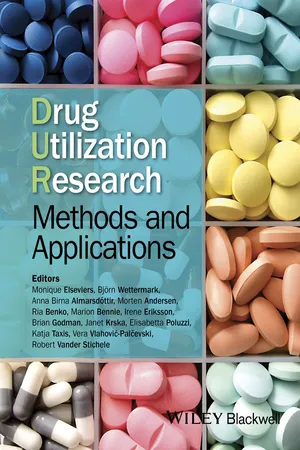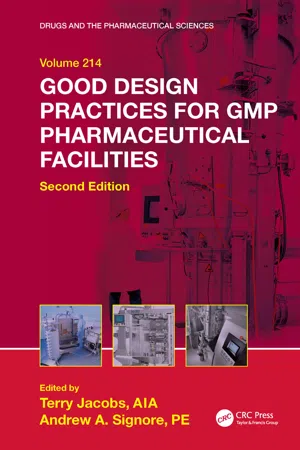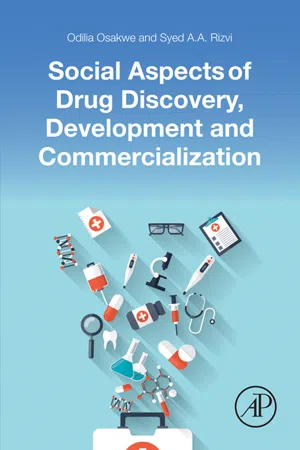History
The Pharmaceutical Industry
The pharmaceutical industry refers to the sector involved in the research, development, production, and marketing of drugs and medications. It has a long history dating back to ancient civilizations, but the modern pharmaceutical industry began to take shape in the 19th century with the development of synthetic drugs and the establishment of pharmaceutical companies. This industry plays a crucial role in healthcare by providing essential medications to treat and prevent diseases.
Written by Perlego with AI-assistance
Related key terms
11 Key excerpts on "The Pharmaceutical Industry"
- eBook - ePub
The World's Health Care Crisis
From the Laboratory Bench to the Patient's Bedside
- Ibis Sanchez Serrano(Author)
- 2011(Publication Date)
- Elsevier(Publisher)
*This chapter summarizes the history of the biopharmaceutical industry (and of the key policies that regulate drug development) up to the year 2000. The Pharmaceutical Industry, as we know it today, began in Germany, indirectly, out of the dye and coal-tar industries. World War I had a negative impact on European firms because of embargoes made by the USA in retaliation for anticompetitive practices, mostly by German and Swiss companies. This was a great opportunity for US companies (such as Merck, the US subsidiary of the German homonymous company), to revamp their infrastructures. By the late 1980s, companies had realized that their old business models needed to change for them to survive. They also realized that they needed to embrace biotechnology. In the 1990s, the industry had no option but to merge because companies’ pipelines were almost empty, and there was a large wave of mergers and acquisitions that solved the pharmaceutical problems and allowed the introduction of many important billion-dollar products in the short term, but that created a crisis in the long run, the effects of which we are seeing today.Keywords: History of The Pharmaceutical Industry; history of the biotechnology industry; quinine; coal-tar derivatives; bacteriology; physiology; XIX century science; chemistry; early pharmaceutical companies; early European pharmaceutical companies; German pharmaceutical companies; Swiss pharmaceutical companies; English pharmaceutical companies; American pharmaceutical companies; academia-industry relationship; mergers and acquisitions (M&A); R&D; World War I and The Pharmaceutical Industry; World War II and The Pharmaceutical Industry; basic research; applied research; regulation of biotechnologyI have always told you that History is boring!— Indro Montanelli, Storia d’Italia1.1 - eBook - ePub
The Pharmaceutical Industry
A Guide to Historical Records
- Lesley Richmond, Julie Stevenson(Authors)
- 2017(Publication Date)
- Routledge(Publisher)
The British pharmaceutical industry since 1851TAB CORLEYCentre for International Business History. University of ReadingBritain’s pharmaceutical industry, like its petroleum industry, is one which possesses a national comparative advantage both technologically and in the balance of overseas trade; yet it is not easy to delineate. Until quite recently, some member companies also made ranges of different products such as foodstuffs, household goods and heavy chemicals. Moreover, many producers in the UK are subsidiaries of overseas pharmaceutical corporations. Even so, the companies involved do form a recognisable industry, competing among themselves in the field of high-technology health care.The outlines of such an industry began to emerge in the 1930s but became far more distinct after 1948 when the National Health Service (NHS) was set up. Official policies of actively encouraging the technological leaders – foreign as well as British – at the expense of the less adventurous followers, through its pricing and clinical testing rules for prescription drugs, allowed those comparative advantages to be built up. Vigorous competition flourishes also in marketing and in distribution to retail chemists and to other outlets for both ethical drugs and over-the-counter remedies.This essay outlines some of the principal changes that have taken place from 1851 onwards in the systems of manufacture and distribution of these medicines. It also addresses the question of how and why the transformation occurred from low- to high-technology production, from small to large scale, and from dependence on imports of advanced drugs to a high degree of self-sufficiency at home.The Industry’s Origins 1851-1914
While the term ‘pharmaceuticals’ was used as early as the 1880s to describe the core products treated here, successive UK Censuses of Production from 1907 to 1935 classified them as ‘drugs, medicines and medicinal products’. Since the first post-war census of 1948, the adjective ‘pharmaceutical’ has been included in the sub-group of Order V. Chemicals and allied industries’. The earlier terminology indicates that during the pre-1939 era, firms making these products fell into three, sometimes overlapping, categories. - eBook - ePub
A Brief History of Pharmacy
Humanity's Search for Wellness
- Bob Zebroski(Author)
- 2015(Publication Date)
- Routledge(Publisher)
American Pharmacy: A Collection of Historical Essays, edited by Gregory J. Higby (Madison, WI: AIHP, 2005), 58.24 Glenn Sonnedecker,Kremers and Urdang’s History of Pharmacy, 328. Dennis B. Worthen,Heroes of Pharmacy, 203–204.25 George Urdang, “Retail Pharmacy as the Nucleus of The Pharmaceutical Industry,” 338. Glenn Sonnedecker,Kremers and Urdang’s History of Pharmacy, 328.26 John Swann, “The Evolution of the American Pharmaceutical Industry,” 80.27 Gene R. McCormick, “Josiah Kirby Lilly, Sr.,”Pharmacy in History, Vol. 12 (1970), No. 2, 57. Glenn Sonnedecker,Kremers and Urdang’s History of Pharmacy, 331. George Urdang, “Retail Pharmacy as the Nucleus of The Pharmaceutical Industry,” 340.28 George Bender,Great Moments in Medicine(Detroit, MI: Northwood Institute Press, 1965), 368.29 Ramunas A. Kondratas, “The Biologics Control Act of 1902,” inThe Early Years of Federal Food and Drug Control(Madison, WI: AIHP, 1982), 10. John Swann, “The Evolution of the American Pharmaceutical Industry,” 80.30 George Griffenhagen,150 Years of Caring(Washington, DC: APhA, 2002), 132.31 Dennis B. Worthen, “The Pharmaceutical Industry, 1902–1952,” 62.32 Dale Cooper, “The Trading With the Enemy Act of 1917 and Synthetic Drugs,”Pharmacy in History, Vol. 47 (2005), No. 2, 48.33 George Urdang, “Retail Pharmacy as the Nucleus of The Pharmaceutical Industry,” 342.34 Glenn Sonnedecker,Kremers and Urdang’s History of Pharmacy, 332. Dennis B. Worthen, “The Pharmaceutical Industry: 1902–1952,” 64.35 Diarmuid Jeffreys,Aspirin: The Remarkable Story of a Wonder Drug(New York: Bloomsbury, 2004), 270.36 Ibid., 260.37 Dale Cooper, “The Trading With the Enemy Act of 1917 and Synthetic Drugs,” 48.38 Dennis B. Worthen, “The Pharmaceutical Industry, 1902–1952,” 64.39 George Bender,Great Moments in Medicine, 372–385. George Bender,Great Moments in Pharmacy - Paul Weindling(Author)
- 2014(Publication Date)
- Routledge(Publisher)
9 Pharmaceutical innovation in the public and private spheres in the twentieth century Viviane Quirke IntroductionThe growing role played by medicine in the lives of people in the West is in large part the result of pharmaceutical innovation, for over the twentieth century drugs have increasingly complemented, or at times even replaced, other forms of therapy or care. This has been due not only to the effectiveness of the drugs themselves, which have enabled the medical profession to prevent, treat, or cure a wide variety of diseases, but also to the marketing and other business strategies of drug companies, which have helped to shape physicians’ and patients’ choices, transforming the consumption as well as delivery of healthcare, and contributing to the interweaving of private firms and public bodies that characterizes modern societies. This chapter therefore examines the interaction between the public and private spheres that has underpinned pharmaceutical innovation.1 To set the scene it begins with an overview of pharmaceutical innovation, before commenting on the public–private interactions underlying it.Pharmaceutical growth, the medicalization of society, and the ‘Therapeutic Revolution’2One of the most remarkable features of the history of the twentieth century has been the growth of The Pharmaceutical Industry, and the rapid increase in the consumption of its products, particularly in the West (i.e. in North America and Europe (mainly Germany, France, Italy, Spain, and the UK) and Japan. By the end of the century, worldwide sales by drug companies were valued at around $350 billion, and have continued to rise.3 By 2014, total global spending on prescription medicines reached over $1 trillion. It is expected to reach $1.2 trillion by 2017, with the major markets (now also joined by China) contributing 59 per cent of the increase.4- eBook - ePub
Pharmacy
What It Is and How It Works
- William N. Kelly(Author)
- 2018(Publication Date)
- Routledge(Publisher)
18 The Pharmaceutical and Biotechnology IndustryINTRODUCTION
Not that long ago, the usual choices for new pharmacy graduates were in community or hospital practice. Since 1980, the opportunities for pharmacists have exploded. One of these opportunities is working in the pharmaceutical and biotechnology industry.There have always been pharmacists in The Pharmaceutical Industry. Indeed, several pharmaceutical companies were founded by pharmacists. However, in the past, most pharmacists working in The Pharmaceutical Industry were used as salespeople to convince physicians to prescribe their company’s products. Today, pharmacists work in a wide variety of positions within pharmaceutical companies.This chapter discusses how pharmaceutical companies are organized and highlights those areas within a pharmaceutical company where pharmacists work. Information is presented on the various titles pharmacists hold within The Pharmaceutical Industry, the transition from practice, career development, and the pros and cons of working for a pharmaceutical company.LEARNING OBJECTIVES
After reading this chapter, you should be able to:- Discuss how pharmaceutical companies are organized.
- Identify the departments in the pharmaceutical and biotechnology industry in which pharmacists work.
- Name three job titles held by pharmacists in the pharmaceutical and biotechnology industry.
- Discuss some of the issues associated with going from practice to the pharmaceutical and biotechnology industry.
- Explain how pharmacists can grow within the pharmaceutical and biotechnology industry.
- Contrast the pros and cons of working as a pharmacist in the pharmaceutical and biotechnology industry.
PHARMACEUTICAL COMPANIES
The Pharmaceutical Industry is large, diverse, and important. It produces chemicals, over-the-counter and prescription drugs, and other health products. Over 100 pharmaceutical companies are involved in the research of new drugs in the United States. Research-based pharmaceutical and biotechnology companies are devoted to discovering medicines to allow patients to live longer, be healthier, be happier, and lead more productive lives. - Lall Ramrattan(Author)
- 2017(Publication Date)
- Routledge(Publisher)
Chapter 6The Pharmaceutical IndustryIntroduction
Most studies embed pharmaceutical firms within firms in different industries in studies of innovation, prices, and returns to make up for sample size and to infer aggregate industry performance from market structure. But the industry structure appears fragmented at best, with waves of mergers occurring to confront globalization and intellectual property rights (The Economist June 23, 2001). Information about the structural direction that the industry will take resides within the brain cells of the CEOs of major companies.In Chapter 1 , we found that the endogenous growth model predicts nonrivalrous behavior for R&D behavior in a national and global setting. This information translates into process and product innovation at the level of the firm, where R&D, advertising, and productivity are the driving forces for success. We have collected time series from 1980–1999 for seven firms: Abbot Laboratories, American Home Products, Bristol-Myers Squibb, Eli Lilly, Merck, Johnson and Johnson, and Pfizer to investigate rivalry among them. We statistically fitted four equations corresponding to four hypotheses and found that smaller firms tended to set their R&D and advertising budgets taking Merck’s previous outlays as given. However, when Total Factor Productivity is investigated for the same period, large firms tend to react to small firms, reaffirming concerns in the literature regarding size versus innovation.Background
The US Pharmaceutical Industry has enjoyed economies from the aging baby boomer population, aggressive R&D, advertising and productivity efforts, and now from the opportunities available in the global economy. The potential opportunities and challenges for pharmaceutical innovations are tremendous. Groundbreaking advances in technology have led to unprecedented pharmaceutical discoveries. Yet a major concern is that regulations by the FDA will generate low returns to investments in R&D. For instance, the rate of return in the late 1970s fell by a third to its 1960 levels, and the cost of discovering and developing new drugs increased 18-fold (Business Week- eBook - ePub
- Maki Umemura(Author)
- 2011(Publication Date)
- Routledge(Publisher)
2 A historical overview of Japan’s pharmaceutical industry
This chapter surveys the history of Japan’s pharmaceutical industry and examines why it failed to become a global leader. One of the key reasons for the relative weakness of Japan’s pharmaceutical industry lay in the lack of an industrial policy designed to develop a research-intensive, globally competitive industry. The Ministry of Health and Welfare (MHW) – rather than the MITI – regulated Japan’s pharmaceutical industry.1 The government long prioritized public health agendas to produce drugs at low cost for its large population. It also long protected Japanese firms from foreign competition and allowed firms to prosper without substantial investments in R&D. Most Japanese pharmaceutical firms began to pursue R&D much later than their Western counterparts. With their belated adoption of R&D, the Japanese pharmaceutical industry had compromised their ability to compete against Western leaders in a globalizing industry.The history of Japan’s pharmaceutical industry will be examined across seven phases. The first phase was the transition from Chinese to Western medicine from the Meiji period (1868 to 1912) up to the First World War. During this time, the Japanese government adopted Western medicine at the expense of traditional Chinese medicine, and Japanese firms began to import Western, mostly German, drugs.In the second phase, which began during the First World War, Japanese firms shifted from the import to the manufacture of Western-style drugs. This transition was prompted by the sudden end of trade with Germany during the war. Between 1915 and 1945, Japan developed a small pharmaceutical industry and expanded into mainland Asia.The third phase began with Japan’s defeat in the Second World War. Between 1945 and 1952, Japan was occupied by the Allied powers who implemented reforms that transformed Japan – including its pharmaceutical industry. Indeed, the Occupation authorities created the foundations of Japan’s post-war pharmaceutical industry by enabling Japanese firms to produce drugs and establishing modern pharmaceutical regulations to support subsequent development. - eBook - ePub
Drug Utilization Research
Methods and Applications
- Monique Elseviers, Björn Wettermark, Anna Birna Almarsdóttir, Morten Andersen, Ria Benkö, Marion Bennie, Irene Eriksson, Brian Godman, Janet Krska, Elisabetta Poluzzi, Katja Taxis, Vera Vlahovic-Palcevski, Robert Vander Stichele(Authors)
- 2016(Publication Date)
- Wiley-Blackwell(Publisher)
CHAPTER 22 The Pharmaceutical Industry and health policyRichard Torbett1,2 , Donald Han3 & Indranil Bagchi31 European Federation of Pharmaceutical Industries and Associations (EFPIA), Belgium2 IMT Institute of Advanced Studies, Italy3 Pfizer, United StatesKEY POINTS
- Medicines have made a major contribution to population health over many decades.
- An ageing population in much of the developed world means that, despite the challenge for publicly funded health systems, maintaining provision of care in a dynamically efficient and effective way is important to avoiding great economic and societal costs.
- Medicines expenditure is kept efficient by ensuring rational use of cheaper generic medicines on the one hand and scrutinizing value for money of new medicines on the other.
- A variety of tools exist to help assess the value of medicines, increasingly involving the use of real-world data in various forms.
- There needs to be continuous improvement in assessment methods – through a multistakeholder effort – in order to keep pace with new science and to correct for any unintended biases.
Introduction
Medicines are an intrinsic part of any health system. Spending on pharmaceuticals was approximately 17% of all health care expenditure among Organisation for Economic Co-operation and Development (OECD) countries in 2011 [1], making medicines the third largest cost component after inpatient and ambulatory care. However, expenditure on medicines has fallen relative to other areas of health care expenditure in recent years, as the efficiencies generated by the loss of market exclusivity of major products have to a large degree offset the costs associated with the introduction of new medicines.At the same time, the overall demand for health care continues to grow. This trend is likely to continue in the coming decades, as an ageing demographic in much of the developed world is likely to be associated with an increase in the prevalence of several – especially chronic – diseases [2]. As a result, policymakers everywhere are looking to ensure health systems are as efficient as possible, so that health care provision can continue in a financially sustainable way. In this context, the management of the use of medicines – ensuring an appropriate balance between the rational use of cheaper generic medicines and allowing access to innovations, especially those that address unmet need or which can help improve the quality and efficiency of care – has become an important priority. - Terry Jacobs, Andrew A. Signore, Terry Jacobs, Andrew A. Signore(Authors)
- 2016(Publication Date)
- CRC Press(Publisher)
Pharmaceutical products are increasingly in demand around the world as global populations become more prosperous, especially in Asia, which produces a significantly larger consumer base. The emerging middle-class group presently number in the hundreds of millions. Among the growing expectations of this increasingly wealthy base of consumers is a higher standard of living, which includes improved access to affordable health care, which, in turn, becomes a main objective for governments as well as patients for greater access to pharmaceutical products. Thus, growing populations translate into potential growth in The Pharmaceutical Industry worldwide.The rising cost of health care is a significant agenda item for the government. Today pharmaceutical products are reported to be 10%–15% of total health care costs. These costs are clearly a target for efficiencies and regulation as governments and consumers voice their concerns over affordability. Currently, more than 80% of all prescriptions filled around the world are generic products. The generic pharmaceutical industry has expanded significantly over the last decade and has benefited from patent losses of blockbuster drugs and a growing consumption trend.The regulated pharmaceutical industry encompasses production of medicines originating from manufacturing facilities owned and operated by innovator companies, generic manufacturers, and CDMOs. The economic incentives of each of these producers vary considerably as their scale, scope, and incentive markets reflect the diverse global marketplace. Regardless of origin, all pharmaceutical production requires compliance with the cGMPs. While the rules are the same regardless of manufacturer, the risk management approach taken by each manufacturer varies, depending on cultural and geographical considerations. Conformance with cGMP quality standards also varies with the enforcement profile of the regulatory authorities who govern production within their boundaries. Risk-managed pharmaceutical operations can raise the cost of goods. Investments in redundant utility systems, flexible scale, local quality control units, size, configuration, maintenance of physical plant facilities, and other operational considerations contribute to the cost of goods (Figure 1.11 ).FIGURE 1.8 R&D investment: global industries: 2010. (From EvaluatePharma, World Preview 2012, Embracing the Patent Cliff. www.evaluategroup.com )FIGURE 1.9 Global pharmaceutical R&D spending (in US$ billion). (From EvaluatePharma, World Preview 2012, Embracing the Patent Cliff. www.evaluategroup.com- eBook - ePub
Culture, Class, and Development in Pakistan
The Emergence Of An Industrial Bourgeoisie In Punjab
- Anita M. Weiss(Author)
- 2019(Publication Date)
- Routledge(Publisher)
3The Pharmaceutical IndustryThe indigenous pharmaceutical industry in Pakistan is of fairly recent origin, for few firms were operating in this northwest comer of the South Asian subcontinent prior to Partition in 1947.1 Since that time, the industry has experienced three successive waves of growth, each characterized by distinctive types of entrepreneurs and accompanied by differing sociopolitical circumstances. This was followed by a fourth stage of industrial stagnation occurring during the Zulfiqar Ali Bhutto era. Uncertainty regarding the future came to dominate decision-making during the tenure of Zia ul-Haq’s government and continues to persist in the industry..Many of the contemporary leaders of this industry have made the transition from traditional orientations towards work and trading to modern forms of industrial management and expansion. First ushered in after Partition by men who had previously been involved in trading and who felt that there were profits to be made in repacking and manufacturing pharmaceuticals, the industry flourished. The federal government assisted the new industrialists as much as possible, largely through generous import licenses. In time, pharmaceutical professionals and other skilled workers also began to undertake production, though not simply because they thought it might be profitable but rather because they were convinced that there was a need in Pakistan for widely available locally-manufactured allopathic medicines. Thus, it was mainly by chance that the first group of pharmaceutical manufacturers entered into this industry in Pakistan. They were markedly successful in an industry in which they had no previous knowledge, helped by foreign manufacturers eager to set up joint ventures and by their own government. - Odilia Osakwe, Syed A.A. Rizvi(Authors)
- 2016(Publication Date)
- Academic Press(Publisher)
Pharmaceutical innovation provides medical discoveries that are vital to the quality of healthcare and longevity. Increasing additions to the medical database is a way of providing safer and wider medical alternatives to various disease conditions. Pharmaceutical innovation has not been sufficiently sustainable, as it has been marked by periodic breakthroughs and failures. The changing productivity landscape has been attributed to scientific, economic, political and regulatory forces, necessitating adaptations that lead to remolded research and development (R&D) strategies and practices. One of the recurring questions posed is: Is The Pharmaceutical Industry driven by addressing the global disease burden or creating products that would maximize overall yield to the pharmaceutical firm? This chapter will discuss the state of the pharmaceutical enterprise, progress and pitfalls, strategies applied, and measures for improvement.Keywords
pharmaceutical business research and development pharmaceuticals markets blockbuster era patent cliff pharmaceutical productivity big pharma innovators economic growthContents2.1 Introduction302.1.1 Pharmaceutical Innovation302.1.2 The Global Pharmaceutical Business302.2 Evolutionary Trends in Pharmaceutical Innovation322.2.1 The Global Pharmaceutical Discoveries of the Twentieth Century322.3 Advances in Pharmaceutical Innovation Technology362.4 Select Medical Milestones of 2014372.5 Factors Contributing to Pharmaceutical Innovation Setback382.5.22.5.1 Research and Development Productivity38
Index pages curate the most relevant extracts from our library of academic textbooks. They’ve been created using an in-house natural language model (NLM), each adding context and meaning to key research topics.
